状语从句省略时态倒装
- 格式:ppt
- 大小:356.50 KB
- 文档页数:9
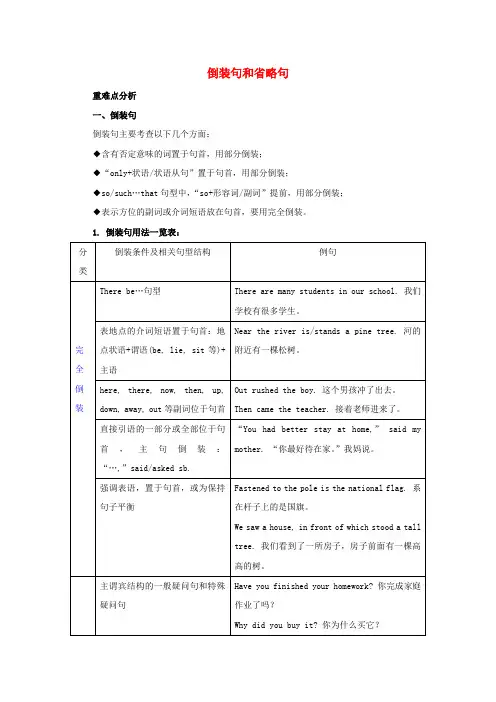
倒装句和省略句重难点分析一、倒装句倒装句主要考查以下几个方面:◆含有否定意味的词置于句首,用部分倒装;◆“only+状语/状语从句”置于句首,用部分倒装;◆so/such…that句型中,“so+形容词/副词”提前,用部分倒装;◆表示方位的副词或介词短语放在句首,要用完全倒装。
1. 倒装句用法一览表:2. 特别提示(1) there be结构的倒装句型中,除了be动词之外,there后还可接lie, live, seemto be等。
如:There lived an old man in the village long long ago. 很久很久以前,村子里住着一位老人。
(2) here, there, now, then, up, down, away, out等副词位于句首,主语为代词时不到装。
如:Away it flew. 它飞走了。
(3) 直接引语的一部分或全部位于句首,主句倒装,主句倒装,但是主语为代词时不倒装。
如:“You have to finish it tonight,” she said. “今晚你必须完成它,”她说。
(4) so位于句首不倒装的情况:① 主语与前句相同,表赞同,译为“确实如此”。
如:— Mike studies hard. 迈克学习很刻苦。
— So he does. 确实是。
② 表示前句内容也适用于另外的人或事,前句如果列举了两种事实以上,用“so it is/was with sb./sth.”回答。
如:— Tom is kind and often helps those in trouble. 汤姆很友好,经常帮助处于困境中的人。
— So it is with his father. 他父亲也是。
(5) 使用as/though进行倒装时注意:①句首有名词,名词不能带任何冠词。
如:Child as he is, he can tell right from wrong. 尽管他是个孩子,却能够明辨是非。
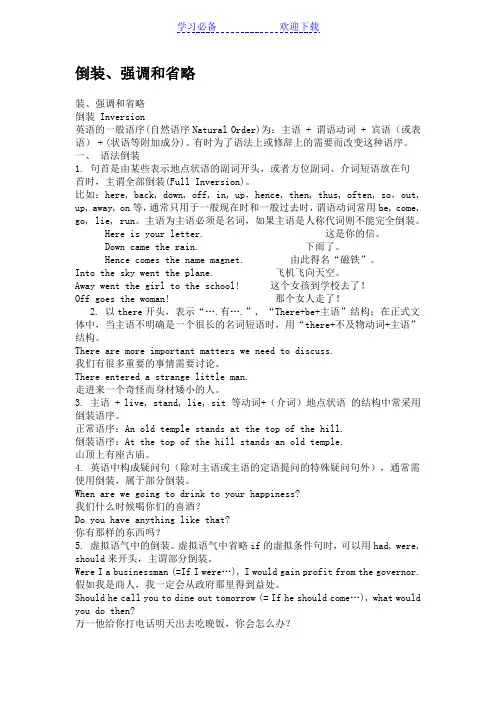
倒装、强调和省略装、强调和省略倒装 Inversion英语的一般语序(自然语序Natural Order)为:主语 + 谓语动词 + 宾语(或表语) + (状语等附加成分)。
有时为了语法上或修辞上的需要而改变这种语序。
一、语法倒装1. 句首是由某些表示地点状语的副词开头,或者方位副词、介词短语放在句首时,主谓全部倒装(Full Inversion)。
比如:here, back, down, off, in, up,hence, then, thus, often, so,out, up, away, on等,通常只用于一般现在时和一般过去时,谓语动词常用be, come, go, lie, run。
主语为主语必须是名词,如果主语是人称代词则不能完全倒装。
Here is your letter. 这是你的信。
Down came the rain. 下雨了。
Hence comes the name magnet. 由此得名“磁铁”。
Into the sky went the plane. 飞机飞向天空。
Away went the girl to the school! 这个女孩到学校去了!Off goes the woman! 那个女人走了!2. 以there开头,表示“….有….”, “There+be+主语”结构;在正式文体中,当主语不明确是一个很长的名词短语时,用“there+不及物动词+主语”结构。
There are more important matters we need to discuss.我们有很多重要的事情需要讨论。
There entered a strange little man.走进来一个奇怪而身材矮小的人。
3. 主语 + live, stand, lie, sit 等动词+(介词)地点状语的结构中常采用倒装语序。
正常语序:An old temple stands at the top of the hill.倒装语序:At the top of the hill stands an old temple.山顶上有座古庙。
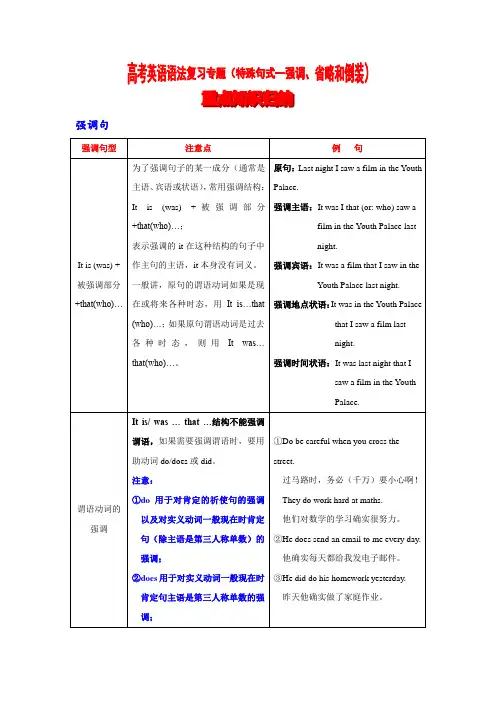
强调句③did用于对实义动词一般过去时肯定句的强调。
It is (was) +被强调部分+that(who)…句型的变式It is (was) + 被强调部分+that(who)…句式基本特征:Is/ Was it +被强调部分+that…;或情态动词+it+ be+被强调部分+ that…①Was it in 1969 ________ the American astronautssucceeded _______ landing on the moon ?A. when; onB. that; onC. when; inD.that; in②Could it be in the restaurant in ______ you haddinner with me yesterday ______ you lost yourhandbag?A. that; whichB. which; thatC. where; thatD. that; where特殊疑问句形式句式基本特征:特殊疑问词+is/was it that…?或特殊疑问词+情态动词+it+be++被强调部分+that…—_______is it _______has made Peter _______heis today?—Determination.A. What; that; thatB. That; that; whatC. What; what; thatD. What; that; what反意疑问句形式句式基本特征:It is/was+被强调部分+that…,isn’t/ wasn’t it?It was Alice and her boyfriend who sent the old manto the hospital, ______?A. do theyB. didn’t theyC. wasn’t itD.was it强调句与其它句型的结合与名词从句的结合句式特征为:整个强调句型用作名词性从句或者在强调句型中含有名词性从句。
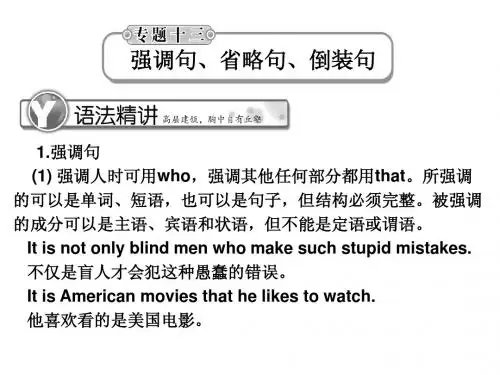
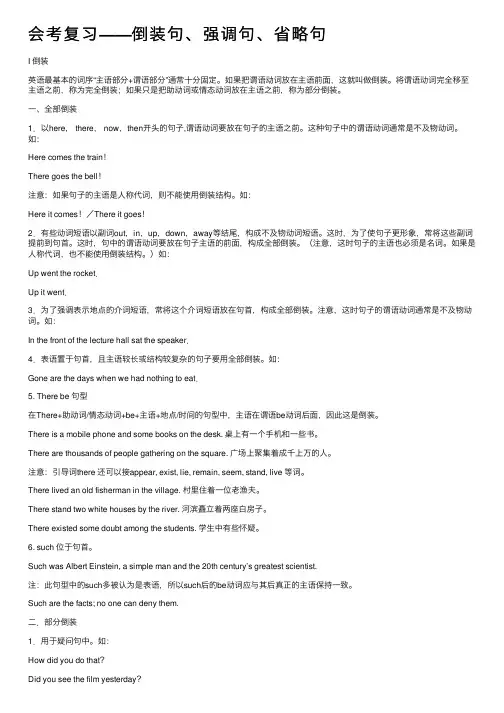
会考复习——倒装句、强调句、省略句I 倒装英语最基本的词序“主语部分+谓语部分”通常⼗分固定。
如果把谓语动词放在主语前⾯,这就叫做倒装。
将谓语动词完全移⾄主语之前,称为完全倒装;如果只是把助动词或情态动词放在主语之前,称为部分倒装。
⼀、全部倒装1.以here, there, now,then开头的句⼦,谓语动词要放在句⼦的主语之前。
这种句⼦中的谓语动词通常是不及物动词。
如:Here comes the train!There goes the bell!注意:如果句⼦的主语是⼈称代词,则不能使⽤倒装结构。
如:Here it comes!/There it goes!2.有些动词短语以副词out,in,up,down,away等结尾,构成不及物动词短语。
这时,为了使句⼦更形象,常将这些副词提前到句⾸。
这时,句中的谓语动词要放在句⼦主语的前⾯,构成全部倒装。
(注意,这时句⼦的主语也必须是名词。
如果是⼈称代词,也不能使⽤倒装结构。
)如:Up went the rocket.Up it went.3.为了强调表⽰地点的介词短语,常将这个介词短语放在句⾸,构成全部倒装。
注意,这时句⼦的谓语动词通常是不及物动词。
如:In the front of the lecture hall sat the speaker.4.表语置于句⾸,且主语较长或结构较复杂的句⼦要⽤全部倒装。
如:Gone are the days when we had nothing to eat.5. There be 句型在There+助动词/情态动词+be+主语+地点/时间的句型中,主语在谓语be动词后⾯,因此这是倒装。
There is a mobile phone and some books on the desk. 桌上有⼀个⼿机和⼀些书。
There are thousands of people gathering on the square. ⼴场上聚集着成千上万的⼈。
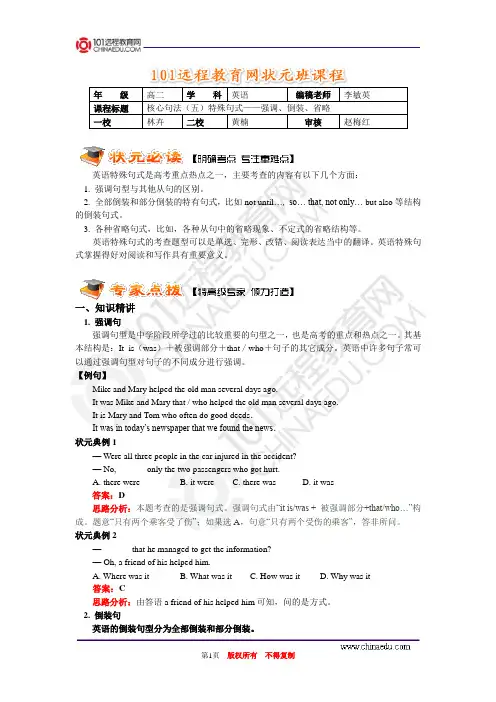
年级高二学科英语编稿老师李敏英课程标题核心句法(五)特殊句式——强调、倒装、省略一校林卉二校黄楠审核赵梅红英语特殊句式是高考重点热点之一,主要考查的内容有以下几个方面:1. 强调句型与其他从句的区别。
2. 全部倒装和部分倒装的特有句式,比如not until…, so… that, not only… but also等结构的倒装句式。
3. 各种省略句式,比如,各种从句中的省略现象、不定式的省略结构等。
英语特殊句式的考查题型可以是单选、完形、改错、阅读表达当中的翻译。
英语特殊句式掌握得好对阅读和写作具有重要意义。
一、知识精讲1. 强调句强调句型是中学阶段所学过的比较重要的句型之一,也是高考的重点和热点之一。
其基本结构是:It is(was)+被强调部分+that/who+句子的其它成分。
英语中许多句子常可以通过强调句型对句子的不同成分进行强调。
【例句】Mike and Mary helped the old man several days ago.It was Mike and Mary that / who helped the old man several days ago.It is Mary and Tom who often do good deeds.It was in today’s newspaper that we found the news.状元典例1— Were all three people in the car injured in the accident?— No, ______ only the two passengers who got hurt.A. there wereB. it wereC. there wasD. it was答案:D思路分析:本题考查的是强调句式。
强调句式由“it is/was + 被强调部分+that/who…”构成。
题意“只有两个乘客受了伤”;如果选A,句意“只有两个受伤的乘客”,答非所问。
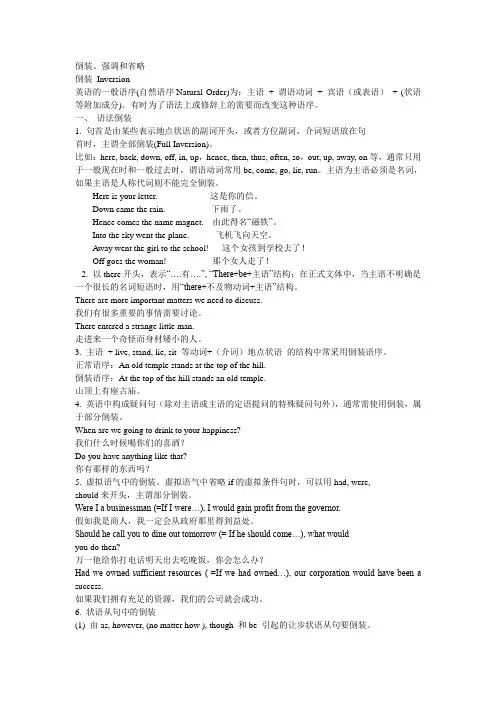
倒装、强调和省略倒装Inversion英语的一般语序(自然语序Natural Order)为:主语+ 谓语动词+ 宾语(或表语)+ (状语等附加成分)。
有时为了语法上或修辞上的需要而改变这种语序。
一、语法倒装1. 句首是由某些表示地点状语的副词开头,或者方位副词、介词短语放在句首时,主谓全部倒装(Full Inversion)。
比如:here, back, down, off, in, up,hence, then, thus, often, so,out, up, away, on等,通常只用于一般现在时和一般过去时,谓语动词常用be, come, go, lie, run。
主语为主语必须是名词,如果主语是人称代词则不能完全倒装。
Here is your letter. 这是你的信。
Down came the rain. 下雨了。
Hence comes the name magnet. 由此得名“磁铁”。
Into the sky went the plane. 飞机飞向天空。
Away went the girl to the school! 这个女孩到学校去了!Off goes the woman! 那个女人走了!2. 以there开头,表示“….有….”, “There+be+主语”结构;在正式文体中,当主语不明确是一个很长的名词短语时,用“there+不及物动词+主语”结构。
There are more important matters we need to discuss.我们有很多重要的事情需要讨论。
There entered a strange little man.走进来一个奇怪而身材矮小的人。
3. 主语+ live, stand, lie, sit 等动词+(介词)地点状语的结构中常采用倒装语序。
正常语序:An old temple stands at the top of the hill.倒装语序:At the top of the hill stands an old temple.山顶上有座古庙。
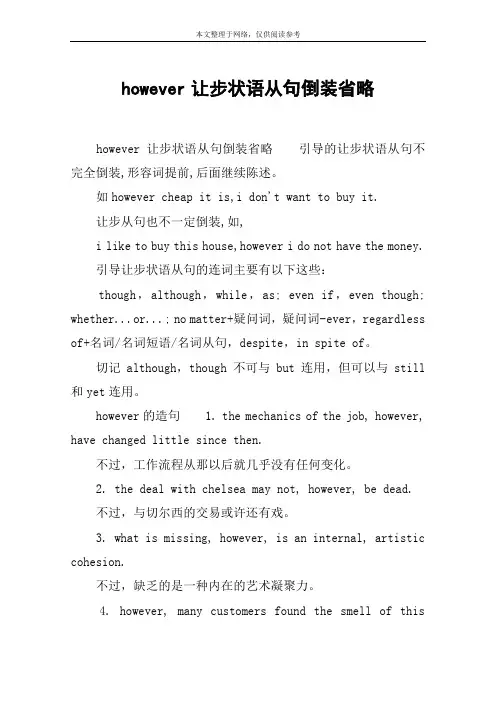
however让步状语从句倒装省略however让步状语从句倒装省略引导的让步状语从句不完全倒装,形容词提前,后面继续陈述。
如however cheap it is,i don't want to buy it.让步从句也不一定倒装,如,i like to buy this house,however i do not have the money.引导让步状语从句的连词主要有以下这些:though,although,while,as; even if,even though; whether...or...; no matter+疑问词,疑问词-ever,regardless of+名词/名词短语/名词从句,despite,in spite of。
切记although,though 不可与but连用,但可以与still 和yet连用。
however的造句 1. the mechanics of the job, however, have changed little since then.不过,工作流程从那以后就几乎没有任何变化。
2. the deal with chelsea may not, however, be dead.不过,与切尔西的交易或许还有戏。
3. what is missing, however, is an internal, artistic cohesion.不过,缺乏的是一种内在的艺术凝聚力。
4. however, many customers found the smell of thisproduct distinctly off-putting.然而,很多顾客觉得该产品有一股异味,非常难闻。
5. when angry or excited, however, he could be wild, profane, and terrifying.但愤怒或激动的时候,他也会发狂、会骂人、令人生畏。

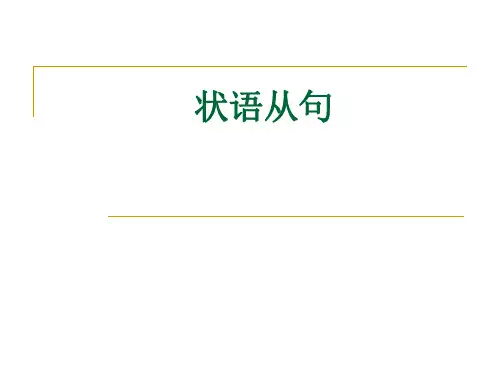
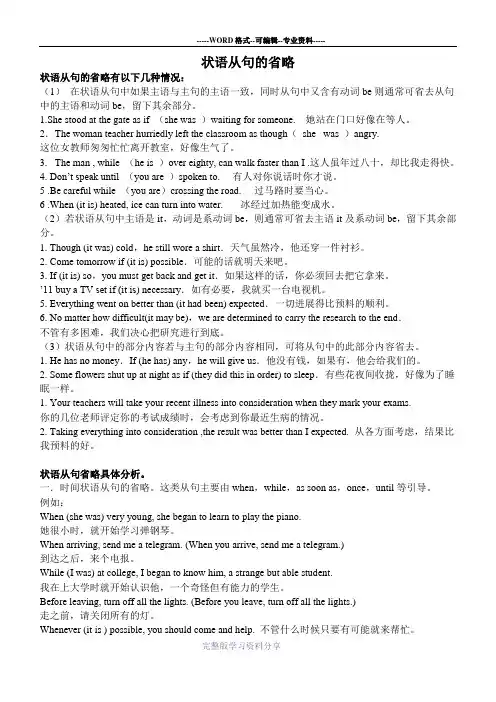
状语从句的省略状语从句的省略有以下几种情况:(1)在状语从句中如果主语与主句的主语一致,同时从句中又含有动词be则通常可省去从句中的主语和动词be,留下其余部分。
1.She stood at the gate as if (she was )waiting for someone. 她站在门口好像在等人。
2.The woman teacher hurriedly left the classroom as though(she was )angry.这位女教师匆匆忙忙离开教室,好像生气了。
3. The man , while (he is )over eighty, can walk faster than I .这人虽年过八十,却比我走得快。
4. Don’t speak until (you are )spoken to. 有人对你说话时你才说。
5 .Be careful while (you are)crossing the road. 过马路时要当心。
6 .When (it is) heated, ice can turn into water. 冰经过加热能变成水。
(2)若状语从句中主语是it,动词是系动词be,则通常可省去主语it及系动词be,留下其余部分。
1. Though (it was) cold,he still wore a shirt.天气虽然冷,他还穿一件衬衫。
2. Come tomorrow if (it is) possible.可能的话就明天来吧。
3. If (it is) so,you must get back and get it.如果这样的话,你必须回去把它拿来。
’11 buy a TV set if (it is) necessary.如有必要,我就买一台电视机。
5. Everything went on better than (it had been) expected.一切进展得比预料的顺利。
倒装、强调与省略倒装Inversion英语得一般语序(自然语序Natural Order)为:主语+ 谓语动词+ 宾语(或表语) + (状语等附加成分)。
有时为了语法上或修辞上得需要而改变这种语序。
一、语法倒装1、句首就是由某些表示地点状语得副词开头,或者方位副词、介词短语放在句首时,主谓全部倒装(Full Inversion)。
比如:here, back, down, off, in, up,hence, then, thus, often, so,out, up, away, on等,通常只用于一般现在时与一般过去时,谓语动词常用be, e, go, lie, run。
主语为主语必须就是名词,如果主语就是人称代词则不能完全倒装。
Here is your letter、这就是您得信。
Down came the rain、下雨了。
Hence es the name magnet、由此得名“磁铁”。
Into the sky went the plane、飞机飞向天空。
Away went the girl to the school! 这个女孩到学校去了!Off goes the woman! 那个女人走了!2、以there开头,表示“…、有…、”, “There+be+主语”结构;在正式文体中,当主语不明确就是一个很长得名词短语时,用“there+不及物动词+主语”结构。
There are more important matters we need to discuss、我们有很多重要得事情需要讨论。
There entered a strange little man、走进来一个奇怪而身材矮小得人。
3、主语+ live, stand, lie, sit 等动词+(介词)地点状语得结构中常采用倒装语序。
正常语序:An old temple stands at the top of the hill、倒装语序:At the top of the hill stands an old temple、山顶上有座古庙。
倒装句与省略句倒装句和省略句是英语中常用的两种特殊句式。
倒装句是指由于修辞的需要,谓语动词发生前移的语句。
省略句,省略句子中的某个或某些成分。
有了倒装句和省略句,英语句子家族更加多姿多彩,语言表达也更加丰富了。
一、倒装句英语句子的语序有时由于修辞的需要,把谓语或部分谓语提到主语之前,这样的句子称为倒装句。
倒装句分为完全倒装(谓语全部置于主语之前)和部分倒装(部分谓语放在主语之前)两种。
1 完全倒装句子的主语较长时(多数情况下又没有宾语),因为要避免头重脚轻的感觉,通常把表语或状语放在句子的前面。
例如:Before the thief stood John who was a detective and had arrested him twice.这个小偷的面前站着曾逮过他两次的探长约翰。
In the small box was the ring that he had given her twenty years before.那个小盒里面是那枚他二十年前送给她的戒指。
So shocked was she at the news that he had died the day before.获悉他昨天去世的消息,令她十分震惊。
2 部分倒装(1)so, neither, nor位于句首,表示与前面谓语所述情况相同。
例如:I am a doctor.我是医生。
So am I.我也是(医生)。
He will go skating.他要去滑冰。
So will she.她也要去(滑冰)。
I didn't finish my homework.我作业没写完。
Neither did I.我也没写完。
I haven't been to the Summer Palace.我没有去过颐和园。
Neither have I.我也没有去过(颐和园)。
The two-year-old child can not eat a meal herself; nor can she dress (herself).这个两岁的孩子还不会自己吃饭,她也不会自己穿衣服。
※状语从句中的省略在表示条件、方式、时间、让步的状语从句中,如其主语与主句的主语一致或是代词it,且谓语动词中又有be时,则从句中的主语和be都可以省略。
1.比较状语从句中的省略在以than或as引导的比较状语从句中,如果主语与主句的主语一致,则从句主语与谓语(可以是be动词,也可以是行为动词)均可省略;如果从句的主语和主句的主语不一致,则省略其谓语及与主句相同的部分。
如:Production is going up much faster than (it was) before.生产比以前增加得快多了。
Jane can speak Spanish more fluently than Peter (can speak).珍妮讲西班牙语比彼得讲得流利。
Winter in Guangzhou is not so cold as in Beijing.广州的冬天不像北京的冬天那么冷。
I shall come as early as possible.我会尽快来。
在口语中,than和as及其后的部分可以省略。
I have never seen a more beautiful garden (than this).我没见过更漂亮的花园。
I would rather go with you (than stay here).我宁愿跟你一起去。
Are they as keen about it (as we are)?他们对这件事和我们一样这么迫切吗?2.条件状语从句中的省略在条件状语从句中,与主句中相同的部分可以省略。
例如:I am happy if you are (happy).如果你高兴,我也高兴。
If (it is) necessary, I will ask you for help.如果有必要,我将请你帮忙。
[注] 在条件状语从句中,经常使用一些省略了的固定搭配,如:if any, if necessary, if possible, if so, if not, 或if + 介词短语,if/unless/once + 过去分词等。